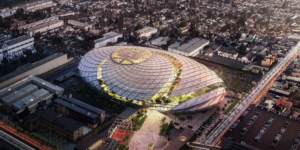
Coming off a complicated year of adjusting to pandemic restrictions, American sports teams are eager to capture spectators and audiences alike with new and improved facilities that could bring major construction job opportunities to their cities.
In keeping with owner Steve Ballmer’s desire to build a “basketball mecca,” the National Basketball Association’s Los Angeles Clippers broke ground on the new Intuit Dome in Inglewood, California on September 17, 2021.
The privately funded arena is projected to have an opening date in advance of the 2024-2025 NBA season, with costs for the project expected to be at $1.8 billion.
Ballmer originally announced the project in 2019, aiming for a 2021 groundbreaking — which the organization was able to proceed with even despite the COVID-19 pandemic and legal and environmental challenges to the construction.
The 18,000-seat arena is sponsored by the California-based Intuit, which will have significant input into the construction process.
“This is our building, but also our building with Intuit and it was very important to have them there at the launch,” Ballmer says.
Though the team currently plays at Los Angeles’ Staples Center — along with the rival Los Angeles Lakers and the National Hockey League’s Los Angeles Kings — the organization is looking to move construction forward quickly to capitalize on the rising popularity of the team itself and the seemingly exponential growth of the NBA’s popularity. The team has noted that construction will be focused on an experience that appeals to a very large demographic.
“It’s about the game of basketball…and we’re trying to get you back in your seat as quickly as we can,” Ballmer says. “We [treated the] upper bowl like the lower bowl…Nobody gets a bad seat, no matter where you sit in the building.”
Though the process has had a number of small roadblocks in its process so far, the organization is also looking to keep the project on schedule for the point of making sure that the Clippers have control over their schedule in a way that they haven’t had when sharing the Staples Center — giving the construction process even more motivation to remain on-schedule.
Facing schedule delays? Explore more resources:

As fans return to sports in large number, many teams are planning new construction iniatives
Though the Clippers’ stadium project is significant, it may not even be the highest-dollar new construction project on the horizon.
The National Football League’s Buffalo Bills have been considering a new stadium for a few years now, and an August 24, 2021, report from The Athletic notes that representatives from Pegula Sports and Entertainment, New York State, and Buffalo’s Erie County met and toured the team’s current Highmark Stadium discuss how much work the 49-year-old stadium needs in order “to remain safe and viable” — possibly pushing the project towards new construction rather than renovation.
Pegula Sports and Entertainment has proposed a $1.4 billion stadium to be built in nearby Orchard Park with 60,000 seats and a targeted 2027 opening date.
The National Football League is certainly pushing for a fully new stadium, as well. NFL Commissioner Roger Goodell made it clear that the league is hoping for much more than a mere renovation of the current stadium, adding that “We’re certainly beyond that.”
“I think a new stadium is what’s needed,” Goodell continues. “I think it’s going to require a public-private partnership. I think the Bills and the community and probably the NFL are all going to have to come together and figure out how to do that in a smart way, and I think we will.”
However, the Orchard Park project isn’t the only option on the table, either. There have been suggestions that the team could instead build the stadium in downtown Buffalo — an option that could send construction costs skyrocketing, with a source noting that it could cost “an extra $500 million to construct and hundreds of millions more in infrastructure accommodations” when compared to the Orchard Park stadium project.
According to a separate report from The Athletic, “A downtown stadium would require so much groundwork that the project would take about 72 months, incurring more labor costs on top of added inflation. The project would require environmental studies and municipal overhauls such as relocating a power substation, electrical cables, water mains, storm sewers, gas lines and fiber optics, all of which are currently in service and would need to be disrupted.”
“We’re not going to get into any details beyond acknowledging the Orchard Park project has a $1.4 billion budget,” Pegula Sports and Entertainment Executive Vice President Ron Raccuia says about the possibility of the downtown stadium.
Though there has been some level of concern over the Bills possibly leaving Buffalo, league officials are aiming to simply create a new space without the threat of total relocation.
“We’re focused on keeping the Bills here in a new stadium in a public-private partnership,” says Goodell. “That’s what this is all about, and that’s where we’re focusing.”
As previous Levelset coverage has touched on, new stadium construction has recently hinged heavily upon public funding, with a common leverage point between major sports teams and cities during negotiations being possible relocating if public funding isn’t allocated to the team’s desired amount.
For the most part, this has been successful, as well: For example, the recently rebranded Major League Baseball Cleveland Guardians recently bucked years of speculation that the team may relocate in joining with the city of Cleveland, Cuyahoga County, and the state of Ohio to renovate the city’s Progressive Field baseball stadium in a $435 million deal.